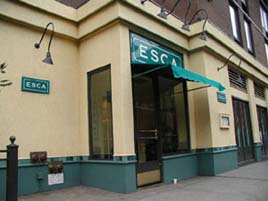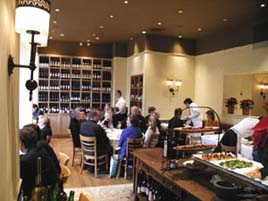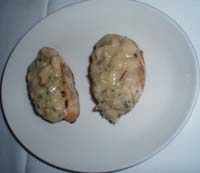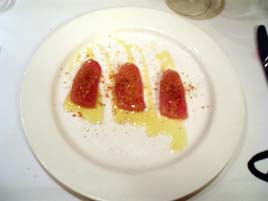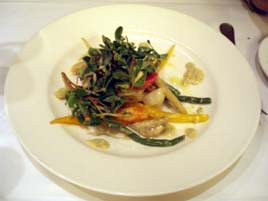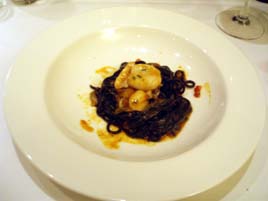Esca
 Monday, October 17, 2011 at 03:00PM
Monday, October 17, 2011 at 03:00PM  I read the occasional bad reviews of Esca from sources I trust, but never enough to persuade me that the restaurant had lost a step since my last visit, four years ago, when I gave it three stars.
I read the occasional bad reviews of Esca from sources I trust, but never enough to persuade me that the restaurant had lost a step since my last visit, four years ago, when I gave it three stars.
The proffer hasn’t really changed: it’s an Italian seafood restaurant from the Batali–Bastianich empire, it remains insanely popular, and I haven’t been served a bad dish yet.
Many of the Batali–Bastianich restaurants take the attitude that you should tolerate the horrible service they mete out, and just consider yourself lucky that you’re fortunate enough to be in their orbit. It has happened often enough to persuade me that it’s not an accident.
I saw none of that at Esca, where the service was so pleasant and solicitous that you’d almost think Danny Meyer had taken it over. The staff even seated me before my girlfried had arrived—practically unheard of at a Batali restaurant.
 Prices have risen only modestly in the four years since my last visit. It looks like every course is about two dollars more, bringing the cost of a four-course meal to around $90 before wine, tax, and tip—about comparable to most of the other New York Times three-star restaurants. But it’s also a menu that’s built for grazing, and you can have an extremely satisfying meal for a lot less than that.
Prices have risen only modestly in the four years since my last visit. It looks like every course is about two dollars more, bringing the cost of a four-course meal to around $90 before wine, tax, and tip—about comparable to most of the other New York Times three-star restaurants. But it’s also a menu that’s built for grazing, and you can have an extremely satisfying meal for a lot less than that.
The amuse bouche, chickpea crostini (above left), seems to be unchanged from my last visit. It’s the least satisfying part of the meal.


To start, my girlfriend had the Polipo, or grilled octopus ($17; above left). It’s an Esca specialty, and the kitchen nailed it. After all these years, it is still hard to find crudo better than Esca’s: Bonita, a fish from the tuna family, was served raw ($18; above right), spackled with crushed almonds and resting in a drizzle of olive oil.


The pasta section of the menu offers just six choices, and four of them are made with chilis or hot peppers, which rather limits the options of a diner who prefers to avoid hot food, as my girlfriend did. Fortunately, the Maccheroni alla Chittara ($25; above left) is a winner. The word chittara refers to a pasta-cutting machine that resembles a harp. Most references spell it “chitarra,” but the team at Esca prefer one ‘t’ and two ‘r’s. Here, it’s served in a subtle, exquisitely balanced sea urchin and crab meat sauce.
I ordered an old favorite, the Spaghetti Neri ($24; above right), a squid ink pasta with cuttlefish, green chilis and scallion, which is as good as it was last time. Esca ought to offer more pastas, as the kitchen has obviously mastered them.


The wine lists are strong at all of the Bastianich restaurants, but at Esca it’s not the epic-length tome as at some of its sister restaurants. Vinosia’s Fiama di Avelino (above left) seemed slightly over-priced at $51, but it paired well with the food.
The restaurant is split into several dining rooms, bustling but not overly loud. The space is functional, but it does not have much charm. The food remains the main attraction.
Esca (402 W. 43rd Street at Ninth Avenue, Hell’s Kitchen)
Food: ***
Service: ***
Ambiance: **
Overall: ***












































